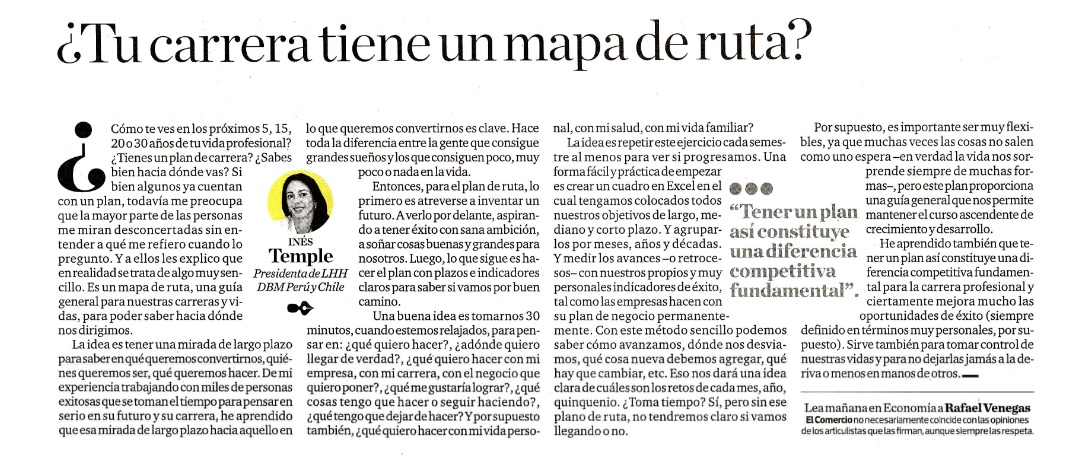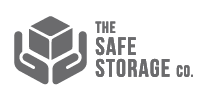Original Spanish version published in the El Comercio newspaper (Peru) on February 4, 2017
How do you see yourself in the next 5, 15, 20, or 30 years of your career? Do you have a career plan? Are you clear about where you are going? Though some people do have a plan, I am still concerned about the large number of people who look at me in bewilderment, without understanding what I am talking about, when I ask those questions. I explain that it is really about something very simple. It is having a road map, a general guide for our careers and lives in order to know where we are headed.
The idea is to have a long-term projection so that we know what we want to become, who we want to be, and what we want to do. From my experience in working with thousands of successful people who take the time to seriously think about their future and career, I have learned that the key is to have a long-term vision of what we want to become. It makes all the difference between people who fulfill their greatest dreams and those who accomplish little, very little, or nothing in life.
So, for a road map, the first thing we have to do is dare to invent a future –see it before us, aspire to succeed with healthy ambition, and dream good and big things for ourselves. Next comes making a plan, with clear deadlines and benchmarks to know if we are on the right track.
A good idea is to take 30 minutes, when we are feeling relaxed, to think about the following: What do I want to do? How far do I really want to go? What do I want to do with my company, my career, or the business I want to start up? What would I like to achieve? What things do I have to do or continue doing? What do I have to stop doing? In addition, of course, what do I want to do with my personal life, with my health, and with my family life?
It would be a good idea to repeat this exercise at least twice a year to see if we are making any progress. An easy and practical way of starting is by creating an Excel chart where we can enter our long-, medium- and short-term goals, and then group them by months and years and decades. That way we can measure our progress –or setbacks–with our own and very personal success indicators, just as companies continuously do with their business plans. With this simple approach, we can see how we are progressing, where we got off track, what new item we need to add, what to change, and so on. This will give us a clear idea of our challenges for each month, year, and five-year term. Does this take time? Yes, but without a road map, we cannot clearly see if we are on our way to reaching our goals or not.
Of course, it is important to be very flexible, since things often do not turn out as we expect –actually, life always surprises us in many ways–, but this plan provides a general guide to help keep us on a rising course of growth and development.
I have also learned that having this kind of plan gives us a competitive edge in our professional career, and undeniably improves our opportunities for success (always defined in very personal terms, of course). A road map also allows us to take control of our life in general, never leaving it adrift, let alone in the hands of others…

The new normal is complex and challenging. Our best positive attitude will be decisive for us to ...
Good leaders seek and create network with other leaders. They know they are responsible for devel...
ncertainty, urgency, or crisis does not give anyone an excuse to be abusive, or act without respe...
Care for yourself by ensuring that you keep stress and workloads at manageable levels. Pass on go...
Original Spanish version published in El Comercio newspaper on April 26, 2020 Whe...
Published in www.ypo.org on September 11, 2020 I am still fascinated by the results of ...
The concerns, motivations, or problems of each team member, as well as the challenges and obstacl...
You are the head of the corporation that is you. Take 30 minutes each quarter to review how much ...
The key is to reframe your attitude so that you don’t fall behind. Recognize your advantages and ...
I continue to work in this and we are making headway, but more respect, empathy, and, sometimes, ...
It’s important to identify our level of employability, recognize its advantages and limitations, ...
Originally published in ceoworld.biz on May 21, 2019 The world of work has changed dramatically, ...
To improve employability, we need to persistently sharpen our work skills and social intelligence...
The challenge is to thoroughly understand our personal reactions to change and immediately focus ...
And yes, we deserve to give ourselves the opportunity to find a job that awakens our enthusiasm a...
Some time ago, I made a mistake, which like all of the mistakes we make, was completely involunta...
Remember that productivity and employability are intrinsically linked –the higher the level of em...
Of course, this is a huge challenge to personal discipline, but we have to appeal to professional...
I want a leader who inspires my respect and admiration for his/her serious, legitimate, and authe...
Original Spanish version published in America Economia (Peru) on September 22, 2016 Ma...
Original Spanish version published in El Comercio newspaper (Peru) on June 11, 2016 “I don’t like...
If you were patient enough to answer these questions and if you made the effort to write the answ...
Original Spanish version published in Aptitus magazine, on May 9, 2018 It is common to see c...
¿Cuántos de nosotros nos sentimos realmente hábiles en las redes? ¿Quién tiene tiempo de calidad ...
What a pleasure it is to help groups of Peruvians to allow themselves to dream and imagine a bett...
When traveling, you remember and compare the experience you had at each hotel where you stayed. ...
The way we answer and the quality of the ideas we express will differentiate us from the others w...
Original Spanish version published in America Economia (Latin America) on March 27, 2018 We ...
Original Spanish version published in El Comercio newspaper (Peru) on March 18, 2018 Twenty-...
Original Spanish version published in El Comercio newspaper (Peru), March 4, 2018 Regardless of t...
Original Spanish version published in El Comercio newspaper (Peru) on February 17, 2018 There are...
Original Spanish version published in El Comercio newspaper (Peru) on January 20, 2018 Hacking, i...
Translation of the original article published December 21, 2017 on América Economía (Latam) Some ...
Original Spanish version published in America Economia (Latin America) on October 23, ...
Original Spanish version published in El Comercio newspaper (Peru) on September 30, 2017 Man...
Original Spanish version published in America Economia (Latin America) on September 2, 2017 There...
Original Spanish version published in El Comercio newspaper (Peru) on July 22, 2017 And when I [&...
Translation of the original article published June 24, 2017 on El Comercio (Perú) Given all the n...
Original Spanish version published in El Comercio newspaper (Peru) on January 4, 2017 We all...
Original Spanish version published in El Comercio newspaper (Peru) on March 4, 2017 As a young [&...
Original Spanish version published in the El Comercio newspaper (Peru) on February 4, 2...
1.Good leaders lead (excuse the redundancy) for the greater good, not to build up their egos, [&h...
Some time ago I wrote about this same subject and was very pleased with the comments […]
Translation of the original article published July 23, 2016 on El Comercio (Perú). Tired of so m...
Original Spanish version published in El Comercio newspaper (Peru) on May 20, 2015 Who wants...
Original Spanish version published in El Comercio newspaper (Peru) on January 1, 2017 Advers...
Being perceived as young or old is now associated more with a series of behaviors and attitudes t...
It’s important to note that our facial expressions, gestures, and posture also send those valuabl...
Original Spanish version published in El Comercio newspaper (Peru) in November 21, 2016 I h...
Original Spanish version published in America Economia (Latin America) on October 28, 2016 As har...


